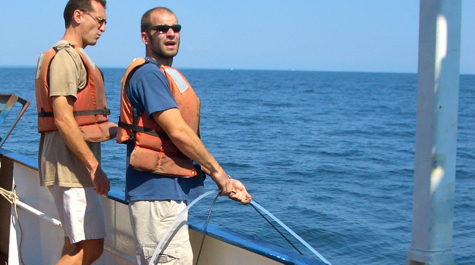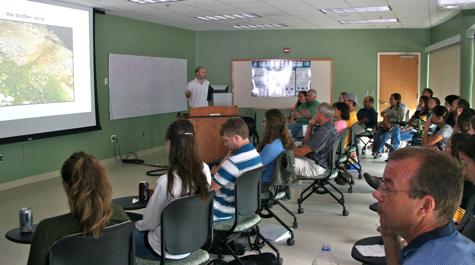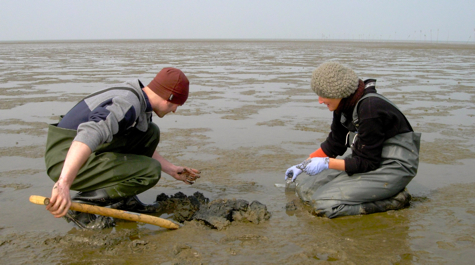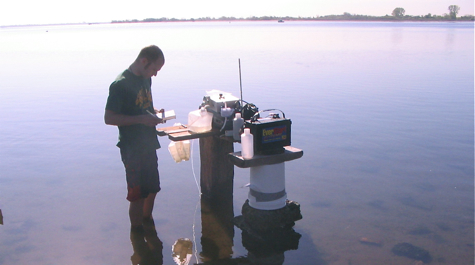VIMS welcomes new faculty member
The Virginia Institute of Marine Science has welcomed Dr. Aaron Beck as its newest faculty member. Beck, a geochemist, was offered the position in 2007 and arrived at VIMS in August after serving a two-year post-doctoral fellowship at the Max Planck Institute for Marine Microbiology in Bremen, Germany.
Beck received his undergraduate degree from Coastal Carolina University in 2003. He earned a Ph.D. in marine science from Stony Brook University on Long Island in 2007.
Beck is excited to be back on the East Coast after spending time in Europe and California. “I love the East Coast from a marine-science standpoint,” says Beck, “and I’m excited about the prospect of coming back to Virginia.” He attended secondary school at TC Williams High School in Alexandria.
Beck is particularly excited about joining VIMS because of its focus on coastal research. “I love coastal science,” he says, “it’s what I like to do.”
Beck was born and raised in South Carolina. He credits his early interest in science to his parents, who were also scientists. “My dad is a botanist, with a Ph.D. in plant physiology, and my mom has a degree in biology,” says Beck. “Both my parents taught science.”
“I always loved the beach, and wanted to be a biologist,” says Beck. “I wanted to study fish, and did shark research during my first summer as an undergrad.”
But an elective course during his sophomore year shifted his interest. “I had a marine chemistry course with a professor I really liked—Jane Guentzel—she was a really good teacher,” says Beck. “That’s when I really got interested in chemistry.”
Professor Rebecca Dickhut, Chair of the Physical Sciences Department where Beck now resides, says her new colleague “adds to our department’s ability to study the fate and transport of heavy metals in the environment, contaminants like lead and mercury. He also brings expertise in groundwater discharge to the coastal ocean, the links between land and water. He brings skills that we didn’t previously have.”
Beck’s most recent research, his post-doctoral project with professor Dirk de Beer, studied a freshwater French stream that has been contaminated with cadmium, lead, and other heavy metals by mining activities. Like other toxic metals, cadmium has been linked to various human ailments. For cadmium, it’s cancer, kidney damage, emphysema, and bone disease.
The novel study—which used state-of-the-art microsensors developed in de Beer’s lab—revealed a clear yet complex link between the stream’s chemistry and its biology. The research showed that cadmium concentrations in the stream water fall sharply during the day, due to photosynthesis by a thin layer of algae on the stream bottom. The uptake of carbon dioxide during algal photosynthesis lowers the water’s acidity, thus driving dissolved cadmium onto the solid surfaces of suspended particles, bottom sediments, and the algae. This has important implications for the uptake of cadmium into the food web, for instance by increasing the chances that bottom-feeding fish that are active during daytime will ingest the metal.
This interaction between biology and chemistry intrigues Beck. “The biogeochemical perspective characterizes what I want to do,” he says. “I like that cross-disciplinary approach, it makes the science more relevant in the real-world, instead of just looking at it solely from a chemical or a biological perspective.”
At VIMS, Beck plans to continue pursuing research at the intersection of the two fields.
“I’m really interested in groundwater discharge to the ocean,” he says. “There’s something called the subterranean estuary—the mixing zone of fresh and salty groundwater—and we really don’t know much about that. It’s pretty new stuff, there’s no one studying contaminant trace metals there, and very little trace metal work at all. That’s something I’m really excited about getting into.”
Beck is also keen to do trace-metal research in Chesapeake Bay. He’s particularly interested in exploring “contrast” agents—heavy-metal compounds used in medical imaging—to track the source of contaminants in wastewater.
“When you get an MRI, they give you a stable compound with gadolinium in it, which courses through your body to help the device record its images. But these compounds are so stable that when they get into marine environment through wastewater, they behave conservatively. So you can use them as a tracer for sewage discharge.”
Focusing on an element like gadolinium shows that Beck is in tune with the kind of forward-looking research for which VIMS is known. “The last really good wastewater tracer was silver, from developing photographic film,” he laughs. “Obviously that’s been declining, since the advent of digital photography.”
Beck says he’s surprised at how little trace metal work has actually been done in the Chesapeake. “It’s typically focused on one particular element— titanium or manganese, for instance—so there’s a lot more to be done.”





